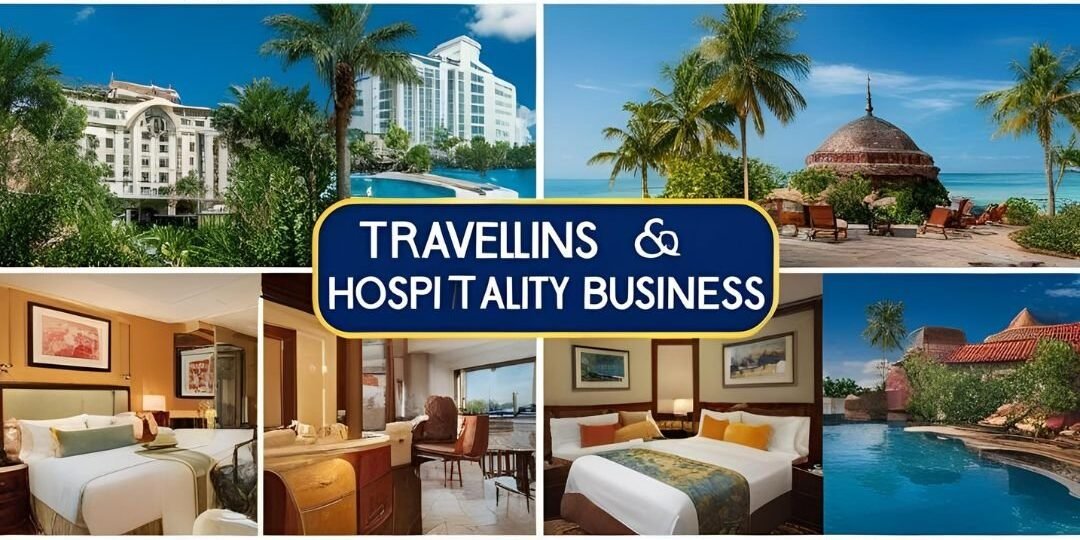Digital Marketing Strategy for Travel & Hospitality Businesses by World DMC

A robust digital marketing strategy for travel & hospitality businesses enhances bookings, builds customer loyalty, and increases brand visibility. Simultaneously, personal branding for the founder establishes credibility, attracts industry partnerships, and boosts trust among travelers.
1. Digital Marketing Strategy for Travel & Hospitality Businesses
1.1 Search Engine Optimization (SEO)
Goal: Increase organic traffic and drive direct bookings.
✅ Key Tactics:
- Local SEO: Optimize Google My Business (GMB) for hotels, resorts, and travel agencies.
- Keyword Optimization: Target keywords like “best beach resorts in [destination]” or “luxury travel packages.”
- Content Marketing: Publish travel guides, itinerary suggestions, and hotel reviews.
- Backlink Building: Get featured in travel blogs, magazines, and booking platforms.
📌 Facts & Figures:
- 93% of travelers research online before booking a trip.
- SEO generates an average ROI of 5.3X.
1.2 Pay-Per-Click (PPC) & Paid Ads
Goal: Drive targeted leads and increase direct bookings.
✅ Key Tactics:
- Google Ads: Bid on keywords like “affordable vacation packages” or “luxury resorts in Bali.”
- Facebook & Instagram Ads: Showcase visually appealing ads of destinations & accommodations.
- YouTube Ads: Share immersive travel experiences and virtual hotel tours.
- Retargeting Ads: Engage users who visited your website but didn’t book.
📌 Facts & Figures:
- Google Ads can deliver an ROI of $8 for every $1 spent in the travel industry.
- Retargeting ads increase booking conversions by 70%.
1.3 Social Media Marketing & Influencer Collaborations
Goal: Increase brand awareness and customer engagement.
✅ Key Tactics:
- Instagram & TikTok: Share stunning visuals, travel stories, and user-generated content.
- Facebook Groups & Community Engagement: Build a travel-loving audience.
- LinkedIn (for B2B hospitality): Target corporate clients, travel agencies, and event planners.
- Influencer Partnerships: Collaborate with travel bloggers and vloggers for authentic promotion.
📌 Facts & Figures:
- 52% of travelers are influenced by social media in their travel decisions.
- User-generated content has a 4.5X higher engagement rate than brand-generated content.
1.4 Content Marketing & Storytelling
Goal: Inspire travel decisions and create an emotional connection.
✅ Key Tactics:
- Blogging & Guest Posts: Publish travel tips, destination guides, and cultural insights.
- Video Content & Vlogs: Showcase real traveler experiences and behind-the-scenes hotel operations.
- Webinars & Virtual Travel Experiences: Offer pre-trip guidance and Q&A sessions.
- Seasonal & Thematic Travel Content: Promote “Best Winter Destinations” or “Romantic Getaways.”
📌 Facts & Figures:
- Brands that use storytelling in content marketing see a 22X higher engagement rate.
1.5 Email & Marketing Automation
Goal: Retarget visitors and increase repeat bookings.
✅ Key Tactics:
- Personalized Offers: Provide exclusive deals based on customer preferences.
- Automated Follow-Up Sequences: Remind users to complete unfinished bookings.
- Loyalty Programs & Discounts: Reward repeat customers with perks.
📌 Facts & Figures:
- Email marketing generates an ROI of $42 for every $1 spent.
- 45% of repeat travelers book again with brands that engage them through email.
1.6 Conversion Rate Optimization (CRO) & User Experience (UX) Improvements
Goal: Increase bookings and reduce cart abandonment.
✅ Key Tactics:
- Simplified Booking Process: Reduce the number of steps in the checkout flow.
- A/B Testing: Optimize CTA buttons and landing pages.
- Live Chat & AI Chatbots: Provide instant customer support.
- Mobile Optimization: Ensure a seamless experience on mobile devices.
📌 Facts & Figures:
- A well-optimized booking website can increase conversion rates by 30-50%.
- 57% of travelers abandon a booking if the website is difficult to use on mobile.
1.7 Online Reputation Management & Reviews
Goal: Build trust and enhance credibility.
✅ Key Tactics:
- Encourage Guest Reviews: Collect feedback on Google, TripAdvisor, and Yelp.
- Monitor & Respond to Reviews: Address negative feedback professionally.
- Highlight Testimonials & Success Stories: Feature happy customer experiences.
📌 Facts & Figures:
- 95% of travelers read online reviews before booking.
2. Personal Branding Strategy for the Founder
2.1 Thought Leadership & Public Speaking
Goal: Establish credibility in the travel & hospitality industry.
✅ Key Tactics:
- Write Articles on LinkedIn & Travel Blogs: Share insights on tourism trends.
- Guest Appearances on Podcasts & Webinars: Discuss hospitality innovations and travel insights.
- Keynote Speaking at Travel Conferences: Gain industry recognition.
📌 Facts & Figures:
- Brands with visible founders see a 35% higher trust factor.
2.2 Social Media Presence
Goal: Connect with travelers, industry professionals, and influencers.
✅ Key Tactics:
- Instagram & TikTok: Share personal travel experiences and expert advice.
- LinkedIn & Twitter: Post industry updates and hotel business strategies.
- YouTube & Podcasts: Discuss entrepreneurship in travel and hospitality.
📌 Facts & Figures:
- Founder-driven content generates 10X more engagement than corporate pages.
2.3 Video & Content Creation
Goal: Engage the audience and increase brand recall.
✅ Key Tactics:
- Live Q&As & Behind-the-Scenes Stories: Show personal insights into running a hospitality business.
- Guest Interviews & Success Stories: Feature travel influencers and satisfied customers.
- Personalized Travel Recommendations: Share unique, less-explored destinations.
📌 Facts & Figures:
- Video content increases brand recall by 95%.
2.4 PR & Media Exposure
Goal: Gain credibility and attract investors/partners.
✅ Key Tactics:
- Get Featured in Travel Magazines & Business Publications.
- Appear on TV & News Outlets as a Travel Industry Expert.
- Collaborate with Travel Agencies & Airlines for Industry Partnerships.
📌 Facts & Figures:
- Media coverage can boost brand recognition by 60%.
3. ROI & Key Performance Indicators (KPIs)
| Strategy | ROI / Impact Metrics |
| SEO | 5.3X ROI, 93% organic traffic |
| PPC & Paid Ads | $8 ROI per $1 spent |
| Social Media Marketing | 52% traveler influence, 10X engagement |
| Content Marketing | 22X higher engagement |
| Email & Automation | $42 ROI per $1 spent |
| CRO & UX Optimization | 30-50% higher booking conversions |
| Influencer Marketing | $6.50 ROI per $1 spent |
| Personal Branding | 35% higher credibility |
4. FAQs
Q1: How long does it take to see results from digital marketing?
- SEO: 3-6 months
- PPC & Paid Ads: Immediate
- Social Media & Branding: 3-6 months
Q2: How much should a travel or hospitality business spend on digital marketing?
- New businesses: 15-20% of total revenue
- Established brands: 8-12% of total revenue
Q3: What’s the most cost-effective marketing strategy?
- SEO & Content Marketing (Long-term growth)
- Influencer Collaborations (High-trust marketing)
- Social Media Engagement (Community building)
Final Thoughts
A successful travel & hospitality marketing strategy integrates SEO, PPC, social media, influencer collaborations, and storytelling, while personal branding for the founder strengthens credibility and attracts partnerships.



